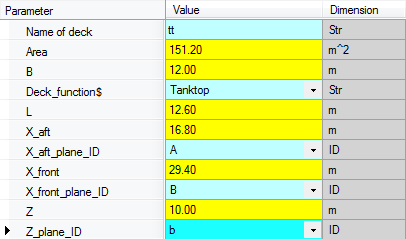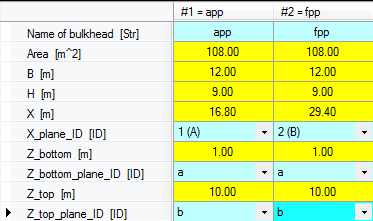Page History
...
| Info |
|---|
Entities can have one of three colors:
|
...
Once an input value is given, the cell color changed changes to light blue. You can always change your input values later on.
...
You see that yellow and white cells are shown. A yellow cell means that a value is a Top Goal for the analysis (inside the entity) and it will be determined by a relation. For example, select Lpp in the Entity (shown in Figure 13) and you can see that the value is computed by means of the relation Lpp = Entiy#Entity#(20).Lpp, as shown in the Explanation window on the leftright.
If you do not have the explanation part “Computed in solution by:”, please select Tools > Options > Explanation and check Requested by/determined by.
...
You have selected optional entity Decks, so you have to indicate the number of Deck entities you want to include and these automatically be placed . These will be automatically placed below entity Decks. In this tutorial we need two decks.
...
As you can see above, the total accommodation area will be computed at the level of entity Decks. Total_accommodation_area results from the summation of all areas of Deck's, using the Deck_function$ named 'Accommodation'.
- Select the first entity
Deckin the tree. - Enter input values as shown here and click Next:
...
For the second deck the same parameters are requested. Here, another Deck_function$ is used. Please note that in the mean time, the entity node name in the tree view of the first deck is changed into a more recognizable name than just Deck. Now the entity node name of the first Deck contains the name of the deck and the deck height.
- Select the second entity
Deckin the tree. - Enter input values as shown here and click Next:
Now, Bulkheads is selected in
- Select entity
Bulkheadsin the tree.
This ship configurator uses ant an entity structure for defining (transverse) bulkheads that differs from the one used for the decks. Of course, the same entity structure could be used, but it is more instructive to present a different presentation form. First, you have to provide the number of bulkheads you want to include in your ship design.
...
Now a table of two columns is created in the table view, each representing a singular single bulkhead. After completing entity Bulkheads the ship lay out is completed.
- Enter input values as shown here and click Next:
4.10 Mass calculation
If the ship lay out is finalized (it is always possible to change values afterwards) the first analysis, Mass calculation, can be performed. Figure 23 presents Entities below Entity “Mass calculation”. In here the mass and the centre of gravity of the whole system will be calculated, which depends on the mass and centre of gravity of both light ship weight and weight of cargo objects. The total mass is calculated by the summation of all mass components. The centre of gravity of a system of components is defined as the average of their positions, weighted by their masses. This method is used at every level within the Mass calculation.
...
Figure 23: Tree view mass calculation
At the level of Entities “Mass Calculation”, “Light ship Weight” and “Mass Cargoes” no input is requested to the user. So click “Accept input & Continue”. Quaestor calculates all information in these Entities when all required information from lower Entities is available.
4.11 Provide input values for Entity Mass Hull
Based on the results of Entities “Main Dimensions” and “Hydrostatics” below Entity “Hull” the centre of gravity and volume of the hull is determined. Scroll through the parameter list to see the used relations in the Explanation window. For this simplified ship configurator we assume that the mass of the hull can be computed by:
Mass = Weight_volume_factor* Volume
As user you only have to provide a weight volume factor, for example 0.5 [t/m3], see Figure 24. The moments around the X, Y and Z axis are determined by Mass multiplied by respectively COGX, COGY and COGZ.
Figure 24: Example input Entity "Mass hull"
4.12 Mass calculation of Decks and Bulkheads
In section 4.8 you already defined the names and positions for a number of decks; in this tutorial two decks were defined. Entity “Decks”, below Entity “Mass Decks”, presents a table, containing for each defined Deck; the deck name, the (deck) area and the centre of gravity, see Figure 25.
Figure 25: Provide weight factor for every deck you have defined
Again, a yellow cell means that a value is a top Goal for the analysis and it will be determined by relations. The parameters “Nr”, “Name of deck”, and “Area”, are automatically copied from the defined “Deck” Entities below Entity “Lay out”. When you add or remove a deck, or change properties of an existing defined deck, these adaptations will automatically propagated to the “Mass Decks” Entity.
The centre of gravity of a deck is based on the given location in your ship design. For this simplified ship configurator we assume that the mass of the decks can be computed by:
Mass = Weight_area_factor* Area
As user you only have to provide a weight area factor for each deck, for example 0.02 [t/m2] and 0.03 [t/m2]. The mass calculation as applied for decks is also used for the mass calculation of bulkheads. Figure 26 shows example input for Entity “Bulkheads” below Entity “Mass Bulkheads”.
Figure 26: Example input values Entity "Bulkhead" below Entity "Mass Bulkheads"
4.13 Define number of cargo objects
Besides the light ship weight calculation it is possible to define the name, COG and mass of a number of cargo objects. Further explanation is not needed. Example input values are given in Figure 27. Please note a schematic picture in the Explanation window depicts the vessel coordinate system as support for the user.
Figure 27: Example input values Entity "Cargoes"
4.14 Intact stability calculation
The mass and centre of gravity of the whole system are input for the intact stability calculation. For this tutorial a very unrealistic simplified stability|Co calculation is developed. The moment of area inertia of the waterline area is the only required input value.
Entity “Intact stability” is only included to give an idea how a configurator can be build with a taxonomy approach. Example input values for Entity “Intact stability” is presented in Figure 28.
Figure 28: Intact stability calculation
4.15 Data to Word report
At the moment you leave Entity “Intact stability” with the "Accept input & Continue" button Quaestor jumps automatically in Entity“Data to Word report”. In here you do not have to provide any input values. Quaestor will directly generate (if all information from the previous Entities is available) a little MS Word report. When you have this document open at that moment, you will see the generation of the reports on your screen.
Please be aware that fatal errors may occur when you are actively working in Word while the reports are generated. Therefore, please wait until the documents are closed.
There are two ways to open the created Word documented from inside Quaestor.
- Select the parameter Report_document$ in Entity “Example report” and click on “Click here for value” in the Explanation window below “Name, value & dimension”.
- Double click on the report name behind the parameter Report_document$ (in Figure 29 “Report_151212_2.doc”).
Finally, it is always possible to find and open the document in your project folder on your computer. The example report document is built up from two sub documents (two chapters) that also can be watched / opened separately.
Figure 29: Generation of example MS Word report
4.16 Data to Excel
The main dimensions and a table of deck data will also be written to an Excel file. In here the total deck area will be calculated and the result will be send back to Quaestor in parameter “Total_deck_area”, see Figure 30. If Quaestor knows all the required data the Excel file will be made at the moment you are in Entity “Data to Excel”.
Please note that the knowledge engineer (the developer) can decide whether to leave the Excel sheet (or Work document) open or close it automatically. In the case of the Excel sheet it has been chosen to leave the Excel sheet open.
There are two ways to open an Excel file from Quaestor.
- Select the parameter File_name_Excel$ in Entity “Data to Excel” and click on “Click here for value” in the Explanation window below “Name, value & dimension”.
- Double click on the Excel file name behind the parameter File_name_Excel$ (in Figure 30 “Deck_data_153402.xls”).
Finally it is always possible to find and open the document in your project folder on your computer.
Figure 30: Data to Excel
...
Back to content | Back to Explanation user interface<< Previous | For knowledge engineers: Continue with the tutorial on the creation of a Taxonomy type knowledge base Next >>








